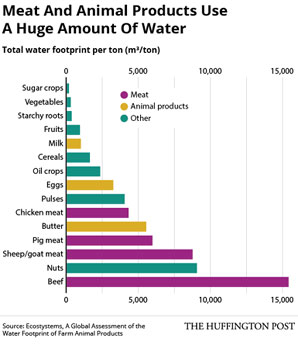by Rona Fried
California’s drought has been in the news this week, and it should be a wake-up call for all of us.
Regardless of where you live, you know your weather is becoming more extreme. The key is the term "unprecedented" – whether it’s drought in the west and southwest (and correlated wildfires), tornadoes in the midwest, or flooding and bitter cold winters in the east.
Encouraged by all the misinformation from climate deniers (and corporations that want you to think everything is fine), Americans are sleepwalking through the advance of climate change – happening right before our eyes.
Much of California has always been dry, that’s not new. If the state’s agricultural industry is so important, why have they not embraced conservation practices in all these years? (They had enough water to get by until now because the state diverted so much water to them).
And, why do Californians consume 40% more water (an average 178 gallons a day) than people who live in NYC?
And this is in a state that’s among the most efficient in the US.
If emissions keep growing, the entire southwest could enter a multi-decade mega-drought by 2050, say researchers. Climate change makes relatively dry places drier and warmer (resulting in more water loss through evaporation) and relatively wet places wetter.
Emergency Actions Could Have Been Done Years Ago
In an "emergency" action, the California Energy Commission just adopted the most advanced water efficiency standards in the nation for homes and businesses – for all new faucets, toilets and urinals sold in the state.
Instead of 2.2 gallons per minute, bathroom faucets will pour water at 1.2 gallons per minute, for example, a 50% improvement. And toilets will use 1.28 gallons of water per flush instead of 1.6 gallons.
After current products are replaced, these small changes will save over 100 billion gallons of water a year – triple the amount the city of San Francisco consumes.
With less water flowing through faucets – especially hot water- the state will also use a lot less electricity to pump and treat water – to the tune of 2.1 gigawatt-hours, more than Sacramento consumes each year. And the amount of natural gas saved could heat more than 1 million homes for a year. All this adds up $1.25 billion in savings, calculates NRDC.
The standards go into effect next year. Why not immediately? Governor Brown did include a temporary, rebate program for people to replace appliances with more efficient models in his executive order.
Agricultural Waste
While California’s agricultural industry supplies almost half of fruits, vegetables and nuts for the US, I was surprised to hear that the industry only contributes 2% to the state’s economy, but accounts for 80% of its water demand.
Clearly, this industry needs to change course dramatically through switching to crops that thrive on little water and installing efficient watering technology like drip irrigation and sensors. This alone would reduce agricultural water demand by 17%, according to the Pacific Institute.
The biggest water consumer is the "production of beef" – for which California ranks #4 in the nation. While we’ve been hearing a lot about water-intensive almond, growing alfalfa is hugely water intensive and it is grown almost exclusively to feed cows.
Perhaps the lack of water will finally get people off consuming so much meat. "Managing demand for animal products by promoting a dietary shift away from a meat-rich diet will be an inevitable component in the environmental policy of governments," says the federal Dietary Guidelines Advisory Committee.
Indeed, meat consumption accounts for 30% of the water used across the US!

Renewable Energy vs Fossil Fuels
Big hydro, nuclear, and fracking all rely on lots of water, but solar PV and wind energy don’t.
While California certainly leads on renewable energy, it has been turning to natural gas as hydro is less available.
Wind energy saved 2.5 billion gallons of water in California last year, and that would increase to 18 billion gallons if it replaced all fossil fuel plants, says the American Wind Energy Association (AWEA).
And wind energy easily filled the gap left by big hydro last year, as it dropped by more than half.
"Through sheer coincidence, much of the nation’s wind generation happens to be located in regions that are most prone to drought. In particular, the agricultural Midwest is home to most of the nation’s wind generation, which has helped reduce consumption of valuable water at the region’s power plants, saving it for use on the region’s vast farmland. Wind’s benefit in the Midwest is particularly large, as the region’s fossil-fired power plants use even more water than those in California and other regions, given the greater use of water-intensive steam-based coal power plants instead of gas combined cycle power plants," says Michael Goggin in AWEA’s blog.
Read, The Untapped Potential of California’s Water Supply, which focuses on water conservation, efficiency, stormwater capture and reuse; and Clean Energy Opportunities in California’s Water Sector:
